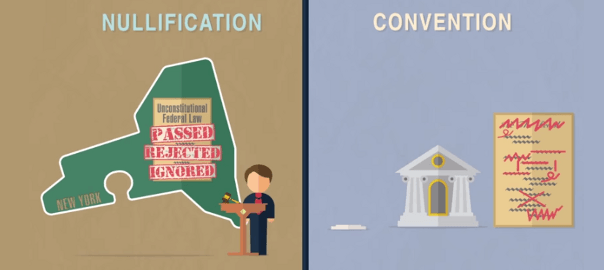1787:
What an important year for America!
At the time, its founders had no idea their experiment, “the Constitution,” would actually work and become the oldest Constitution in use today.
The Founders even went one step further to ensure citizens their individual liberties would always be protected by adding ten amendments, the Bill of Rights.
However, as impressive as the Constitution has been, the federal government has been increasingly ignoring its constitutional boundaries over the last century.
Today, Americans are realizing that the federal government is out of control and are looking for a way to rein it in.
Some are advocating an Article V Convention, also known as a Convention of the States, a Constitutional Convention, or a Con-Con, which provides a way to change the Constitution.
Others are advocating Nullification, which provides a way to enforce the Constitution.
So what is the difference between Nullification and an Article V convention?
- With Nullification, the Constitution is left intact. With this tool States can refuse to enforce unconstitutional federal laws.
- With a Convention, The Constitution would be changed; either by a single amendment, a series of amendments or possibly a complete rewrite that would destroy what our founders gave us.
- With Nullification, responsibility rests with each state’s elected legislature sitting as the authority.
- With a Convention, responsibility rests with delegates appointed or elected from all 50 states. Currently there is no way of knowing who your delegate would be. Let’s think about this; how likely is it that most delegates would be constitutionally minded and looking out for the American people’s best interests.
- With Nullification, it is usually a short process because only one step is required by a state, not several steps as with a convention.
- With a Convention this would be a much longer process. It could take years by the time you choose delegates, have a convention for proposing amendments, and then ratifying those amendments by 3/4s of the States.
As you can see
- With Nullification, the end is known. First, a bill is introduced in a state legislature invalidating an unconstitutional federal law within that state. Next, that bill is passed, rejected, or ignored.
- With a Convention, the end is unknown. Such a Convention would have the inherent power to be a runaway Convention and completely rewrite the Constitution.
So what do you feel more comfortable with?
Americans are correct when they say our government is out of control and that something needs to be done. What many don’t realize is that the Constitution is not the problem; it is our elected officials who are not obeying the Constitution. Changing the Constitution by means of an Article V convention will not fix this problem.
However, tools, such as nullification, can be used to bring the federal government back within its constitutional boundaries.
It is our duty as Americans to maintain our Republic. We can do so through a citizen-based educational program that informs the electorate on the proper role of government. With an informed electorate, we can elect Constitutionally minded individuals who obey the Constitution. It is time to get involved. We the People created the Constitution in1787; now, We the People can preserve our freedom by enforcing the Constitution.
See: Commissioner Littleton & Sheriff Maketa: NDAA Nullified in El Paso County Colorado


